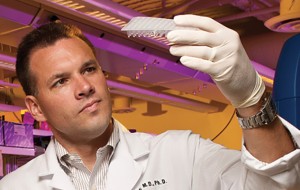
Babies who develop leukemia during the first year of life appear to inherit an unfortunate combination of genetic variations that can make the infants highly susceptible to the disease, according to a new study at Washington University School of Medicine and the University of Minnesota.
The research is available online in the journal Leukemia.
Doctors have long puzzled over why it is that babies just a few months old sometimes develop cancer. As infants, they have not lived long enough to accumulate a critical number of cancer-causing mutations.
“Parents always ask why their child has developed leukemia, and unfortunately we have had few answers,” said senior author Todd Druley, MD, PhD, a Washington University pediatric oncologist at St. Louis Children’s Hospital. “Our study suggests that babies with leukemia inherit a strong genetic predisposition to the disease.”
The babies appear to have inherited rare genetic variants from both parents that by themselves would not cause problems, but in combination put the infants at high risk of leukemia. These variants most often occurred in genes known to be linked to leukemia in children, said Dr. Druley, an assistant professor of pediatrics.
Leukemia occurs rarely in infants, with only about 160 cases diagnosed annually in the United States. But unlike leukemia in older children, which most often can be cured, about half of infants who develop leukemia die of the disease.
The researchers sequenced all the genes in the DNA of healthy cells from 23 infants with leukemia and their mothers. Looking at genes in the healthy cells helped the researchers understand which genetic variations were passed from a mother to her child, and by process of elimination, the scientists could determine the father’s contribution to a baby’s DNA.
Among the families studied, there was no history of pediatric cancers. The scientists also sequenced the DNA of 25 healthy children as a comparison.
“We sequenced every single gene and found that infants with leukemia were born with an excess of damaging changes in genes known to be linked to leukemia,” Dr. Druley said. “For each child, both parents carried a few harmful genetic variations in their DNA, and just by chance their child inherited all of these changes.”
Other children in the families typically don’t develop leukemia because a roll of the genetic dice likely means they did not inherit the same combination of harmful genetic changes, he added.
Dr. Druley said it’s unlikely that the inherited variations alone cause cancer to develop in infants. Rather, the babies likely only needed to accumulate very few additional genetic errors in cells of the bone marrow, where leukemia originates, to develop the cancer in such a short time span.
He and his colleagues now want to study the inherited variations in more detail to understand how they contribute to the development of leukemia. Eventually, with additional research, it may be possible to use a technique called genetic editing to “cut” the harmful gene from the DNA of infants who are susceptible to leukemia and replace it with a healthy version of the same gene, thereby sparing babies and their families from a devastating diagnosis.
Dr. Druley, along with his Washington University colleagues in genetics and oncology, also have established the region’s first Pediatric Cancer Predisposition Clinic, located at St. Louis Children’s Hospital. The team closely follows children with an increased risk of cancer to increase the likelihood that cancers are detected and treated early.
Physical and occupational therapists, audiologists and other health professionals also are available to provide support services to the children. Genetic research conducted through the clinic is designed to improve the surveillance of pediatric cancers and understanding of how and why they develop.